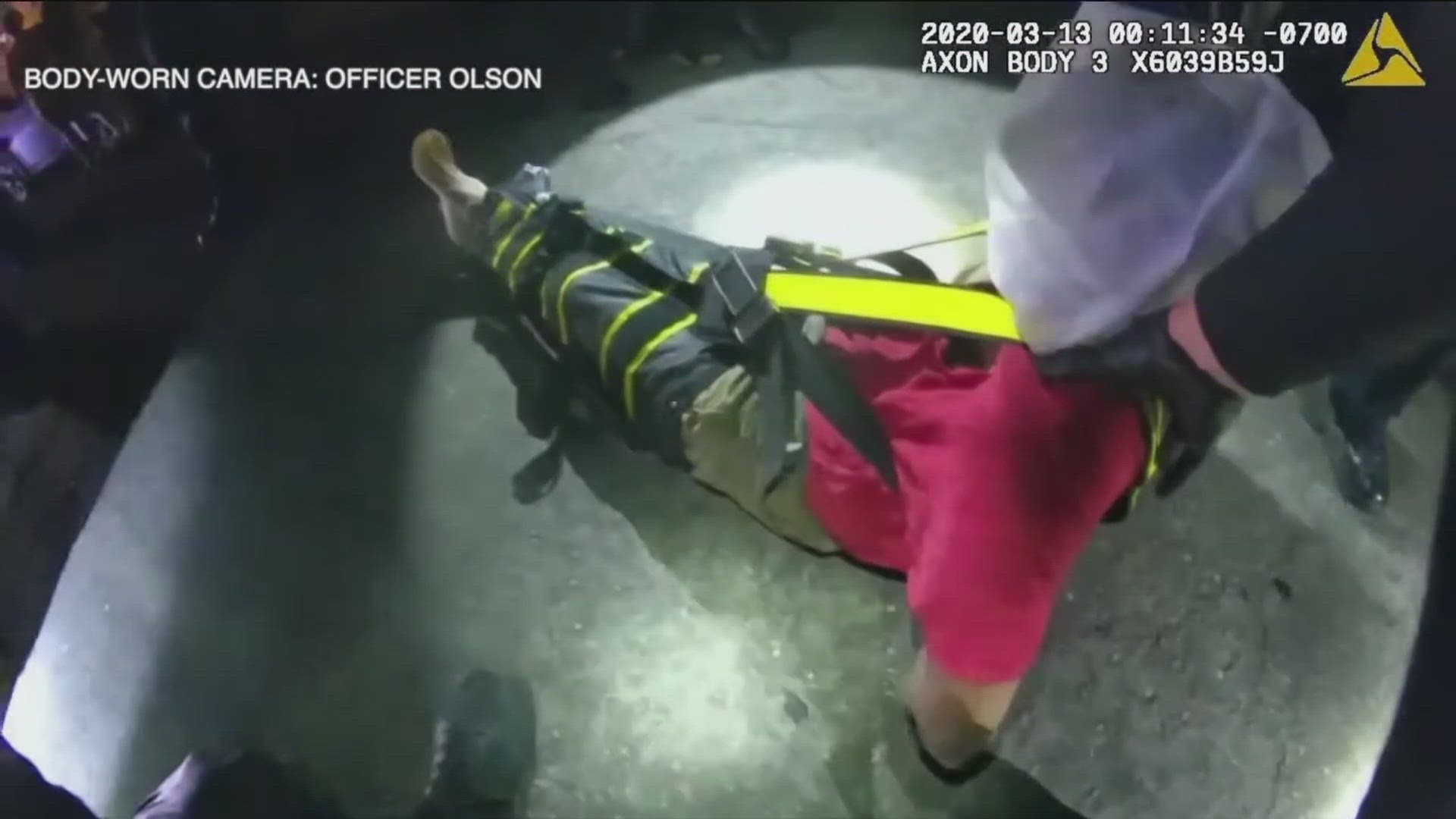Powerful sedatives and in-custody deaths
At least six people in San Diego County who died in custody were injected with powerful sedatives during police altercations.

Warning: The video featured in this story could be found disturbing by some audiences.
The shrieks and full-throated screams coming from inside Wesley Garrett-Henry's room were unsettling as if Garrett-Henry was possessed. The screams echoed through the hallway of the downtown San Diego residential motel where Garrett-Henry lived.
Garrett-Henry's neighbor said that they thought Garrett-Henry had used drugs that day, the first time in what they said was after years of sobriety.
Just before midnight, neighbors heard the screams and called 911.
San Diego Police officers arrived at 11:51 to Henry-Garrett's room. Footage from the officer's body-worn cameras which was obtained by the Associated Press through public records requests, captures the medical distress that the typically healthy Garrett-Henry was experiencing inside.
"Who is this..." yelled Garrett-Henry after screaming obscenities from inside his room as officers stood outside the door.
Seconds later, Garrett-Henry exits his room rapidly, disheveled.
One of the officers told medics that the scene was clear while describing Garrett-Henry in a state of "excited delirium."
Soon, the 32-year-old flails on the ground. He kicks at the wall and squirms on his back as his hands are cuffed underneath.
To control him, the officers flip Garrett-Henry onto his stomach, also known as the prone position. The officers placed their weight on him and asked him to remain calm.
The officers pressed on Garrett-Henry's shoulder and legs for approximately 15 minutes as they waited for medics to arrive.
At 12:10 am, less than 20 minutes after police officers arrive, body cam footage shows a medic quickly run into the camera frame.
The medics asked if the officers needed Versed, also known as Midazolam, a powerful sedative used in hospitals to allow patients to relax before surgery.
Within seconds a medic quickly injected the sedative into Garrett-Henry's left bicep.
Less than ten minutes later, 32-year-old Wesley Garrett-Henry was dead.
An in-depth investigation by the Associated Press and Frontline PBS examined over 1,000 cases of in-custody police deaths where guns were not used and found that more than 10 percent involved the use of powerful sedatives on the subjects in police care.
According to its investigation, the Associated Press found that California had one of the highest number of restraint deaths where sedatives were used in the country.
CBS 8's own investigation discovered that in San Diego County, six people of the 16 in-custody deaths since 2013 where guns were not used had been injected with Midazolam while in custody or while being held in a prone position or placed into police restraints.
While only a few medical examiners found that hospital-grade sedatives such as Midazolam and Ketamine played a part in a person's death, Elijah McClain being one of those, medical professionals have not found, or studied, a direct connection between sedatives and in-custody deaths.
The Associated Press investigation shows that medical experts are growing more concerned about the use of sedatives in those who are in extremely agitated and combative states or those high on methamphetamines and other drugs.
Sedatives, Police and Paramedics
Law enforcement agencies and first responders nationwide have turned to sedatives as a de-escalation tool when dealing with highly agitated and combative people.
In California, the sedative of choice is the powerful sedative Midazolam, which is used in pre-surgery settings and for those experiencing seizures.
Emergency room physicians and nurses also use it to control agitated and combative patients. More recently, states such as Oklahoma now use it as well as the preferred drug for lethal injections.
One concern is sedatives are used to slow heart rate and breathing. Some medical experts say that slowing respiratory functions with powerful sedatives coupled with law enforcement's need to restrain combative subjects, including at times placing weight on their torso or chest, could be a deadly combination.
"There are several issues that intersect when we talk about these sedatives," said Dr. Brooks Walsh, an emergency room doctor in Bridgeport, Connecticut. "It's less important which specific agent it is, and far more important that it is being given for the right reasons and properly monitored. Ketamine and midazolam can both be quite safe agents in the right hands, but they can also be deadly."
Dr. Walsh said that sedatives such as Midazolam and Ketamine are essential in emergency room settings where time is of the essence to diagnose and treat patients who are combative and aggressive.
"We will get a patient who is agitated and combative, but we have concerns for a head injury, low oxygen, brain infection, substance abuse, or a psychiatric episode," said Walsh. "The use of sedatives allows us to expedite the evaluation and get the patient-specific treatment."
Dr. Walsh stressed the difference when using the sedatives in a hospital setting as opposed to using them in the field where officers and paramedics are often forced to deal with several scenarios.
"But the moment we give that sedative, it is 100 percent our job to monitor them and keep them safe, keep them breathing," said Dr. Walsh.
Civil rights attorney Tim Scott of San Diego-based national law firm, McKenzie Scott, has represented several families whose loved ones were given sedatives during violent clashes with police.
Scott says the use of sedatives without permission is another way of using force during police altercations.
“The problem is that this isn’t a medical procedure: it’s an unwanted use of force that sometimes kills people," said Scott. "It’s the same problem with hog-tying or any other use of force—while it might make some police officers feel safer, the truth is people are dying preventable deaths in custody.”
Scott, who represented the family of Lucky Phounsy, and currently represents Adrian Rios, an Azusa man who was administered Midazolam during a psychotic break and is now in a vegetative state, says he and his firm see more cases where sedatives contributed to in-custody police deaths or injuries.
“These sedatives do seem to be a recurring contributing factor in many of these police-restraint deaths. We are seeing it more and more,” said Scott.
As seen in the death of 32-year-old Garrett-Henry, paramedics, and police can often be quick to use sedatives as a method to control a combative person.
In Garrett-Henry's case, paramedics did not provide any medical evaluation before injecting him with a dose of Midazolam.
Instead, in Garrett-Henry's case some of the only words uttered to paramedics and EMTs before giving the injection was, "excited delirium."
Sedatives and Excited Delirium
While a direct link between sedatives and in-custody deaths has not been proven, one constant exists in all deaths and that is the now-banned theory called, excited delirium.
Excited Delirium, is a condition where people show sudden signs of aggressive and oftentimes bizarre behavior. Symptoms, according to a 2011 report published in the Western Journal of Emergency Medicine, include "shouting, paranoia, panic, violence toward others, unexpected physical strength, and hyperthermia."
The theory has long been used by law enforcement agencies, coroners, and district attorneys to describe the actions seen by some during police encounters. If allowed to intensify, the delirium can put so much strain on the heart that those suffering from it could die.
It states that when people with a history of drug abuse and mental health conditions are placed in high-intensity situations, for example, with maximum police restraints, they can grow severely agitated and display feats of superhuman strength before their heart suddenly and inexplicably stops.
On January 1, 2024, a new law in California banned the use of excited delirium by medical examiners, coroners, police officers, and as a legal defense.
And while excited delirium may no longer be used in courtrooms or by police officers, the use of sedatives to try and calm and subdue people in police custody will continue to be used and, says attorney Scott, continue to harm people.
"Medical examiners do not generally attribute in-custody deaths to [Midazolam] injections by paramedics. But they also usually fail to attribute excessive-force deaths to police misconduct," said Scott. "Unfortunately, our experience has been that some Medical Examiners base their cause-of-death determinations more on political expediency and avoiding government liability than science.”
Emergency physician Dr. Brooks Walsh admits more needs to be done to educate first responders about the use of powerful sedatives.
"Emergency medicine physicians didn't validate the concerns of the wider community about the association of these sedation drugs with the death of people in police custody and especially those people who had been labeled as excited delirium," said Dr. Walsh. "I don't blame community advocates and legislators for responding to such deaths with calls to ban the use of them. We in emergency medicine really should have been out in front on this issue, addressing those concerns head-on.
Go here to read the Associated Press/Frontline PBS investigation.


